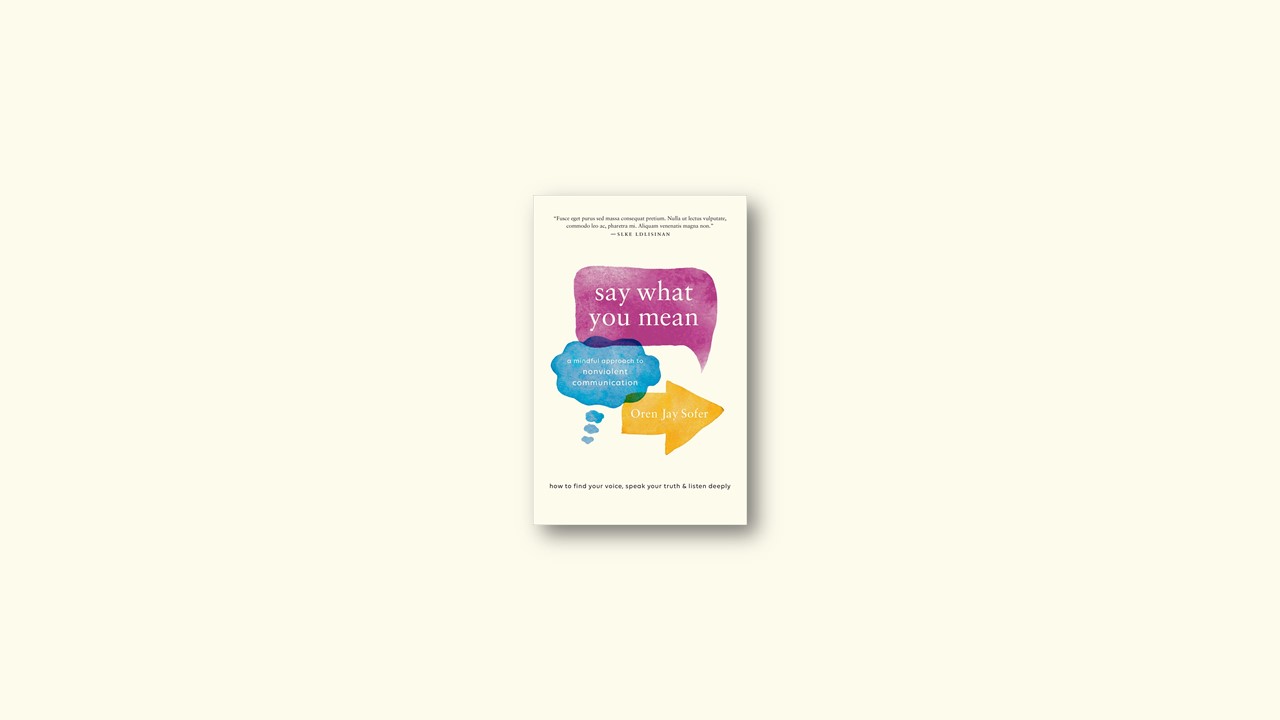Three Steps, Three Foundations
Human communication is complex. There are a myriad of factors in any interaction. Our emotions, ideas, and beliefs come into play both verbally and nonverbally. We have to negotiate patterns of relating that have been established, whether between two individuals or between the groups and communities to which we belong. Yet, in all of this, there are certain consistent foundations to skillful communication.
The overarching framework for this book is taking three steps to create effective conversation. The steps themselves are simple enough:
- Lead with presence.
- Come from curiosity and care.
- Focus on what matters.
Each step is part of a much more thorough and profound training. Like three firm, solid stones placed in the middle of a fast-flowing stream, each step is only as stable and useful as the foundation upon which it rests.
The First Step: Lead With Presence
The first step of mindful communication is to lead with presence, which means that we show up as fully and completely as possible. If we’re not here, we’re probably on automatic. And if we’re on automatic, we’re less likely to remember the tools we’ve learned, come from our best intentions, or access our own wisdom.
THE CENTER OF OUR LIVES
Presence is one of those things that’s hard to pinpoint with language, yet it makes a huge difference in the quality of our life.
Presence is embodied awareness of our direct sensory, mental, and emotional experience.
Having presence for a moment is easy and readily accessible for most people. Staying connected to presence continually is harder—frankly, it takes training. Maintaining awareness in conversation is even more challenging. The tendency to lose presence is strong: we often leave it as soon as we open our eyes. Indeed, it’s amazing how difficult it is to stay here once we open our mouths!
Of course, there are common exceptions: the intimacy we feel in romantic relationships or moments of heightened awareness in nature. In these moments we often feel a profound sense of connection. It is precisely the combination of deep presence in relation to another or our surroundings that creates the potency of these experiences.
Bringing presence to relationship is a powerful practice. It means that we really show up for ourselves, the other person, and whatever happens between us.
THE POWER OF MINDFULNESS
When on your own, give 100 percent of your attention to the anchor. During transitions, place as much of your attention there as feels appropriate to the context. When you’re interacting, put just 10 or 20 percent of your awareness there. At first it may be awkward to do during a conversation. It can feel as if your attention is flipping back and forth between what’s happening and your anchor. This is completely normal. Over time, your mind will learn how to balance external sensory data with a grounded internal presence and maintain a light awareness of your body during conversation.
Initially, much of the work is simply remembering to be present. One way to support this is to take a few moments each morning to set an intention and then to reflect on how things went at the end of the day. This practice can be as brief as two minutes, or longer if you have the time.
PRACTICE: BEGINNING AND ENDING THE DAY
MORNING: Soon after rising, take a few breaths to settle your mind and feel your body. Connect your attention to the reference point with which you’re working: gravity, the centerline, breathing, or a touch point. Notice how it feels to be present right now. Then, set a clear intention to return to this reference point as a support for presence as often as you can during your day. Imagine situations where you want to practice: on your commute, in a meeting, with someone specific.
EVENING: At the end of the day, take some time to reflect. Did you remember? When? What was the effect? Bring an attitude of curiosity and warmth to your reflection, being wary of any self-judgment. What would you like to do differently tomorrow? Do you have ideas for ways you can remember to lead with presence?
The Second Step: Come From Curiosity And Care
The second step of mindful communication is to come from curiosity and care. Our intention can determine the whole tone and trajectory of a dialogue. Intention is where we’re coming from inside. It’s the motivation or inner quality of heart behind our words or actions. You could say it’s the vector that drives what’s happening in one direction or another. Intention is about how and why we speak or listen.
A great deal of our communication is nonverbal: body language, facial expressions, gestures, tone of voice. We can say one thing and communicate the complete opposite. In other words, how we say something is equally important—if not more important—than what we say. All of this is shaped by our intention.
WHERE ARE YOU COMING FROM?
Everything we do, we do to meet a need.
Remembering this perspective is one key to being able to come from curiosity and care. The view calls forth the intention. Whatever is happening, we can get curious about the deeper human needs and values beneath our words or actions. When we understand each other at the level of our needs, our similarities outweigh our differences. This, in turn, creates a generative, positive cycle of views, intentions, and experiences.
The great strength of this approach is that it’s not limited to our intimate relationships. Whether we want to enjoy time with a friend, collaborate with a coworker, or build a diverse coalition, our genuine intention to understand has the power to create or enhance connection (for its own sake and in service of meeting needs).
To employ this in conversation requires a few things. First, we need to build our capacity to come from curiosity and care. We need to really home in on what it feels like to have a genuine intention to understand so that we can bring our mind back there at will. Next, we need to train ourselves to notice when we’re operating from our habitual tendencies. Last, we learn how to find our way back to curiosity and care.
PRACTICE: COMING FROM CURIOSITY AND CARE
Explore cultivating curiosity and care in conversation. Beforehand, reflect on your intention. How do you want to approach things? Where do you want to come from inside? See if you can find a genuine intention to understand the other person—their thoughts, views, feelings, or needs. How does it feel to be genuinely interested?
Try recalling this perspective when you are in conversation. What matters to this person? What do they long for or need? What is the effect when you are able to come from curiosity and care? As always, try this out in low-stakes situations at first.
DON’T LET THE CALL DROP
LISTENING IS A cornerstone of dialogue and a powerful metaphor for spiritual practice. When we come from curiosity and care, we’re willing and able to listen. We’re opening a conduit that allows connection and understanding to happen.
There are so many ways to listen. We can listen to the content of what someone says, to how they’re feeling, to what’s important beneath their words. We can listen halfheartedly or wholeheartedly.
To listen entails a fundamental letting go of self-centeredness. We have to be willing to put down our own thoughts, views, and feelings temporarily to truly listen. It’s a wholehearted, embodied receptivity that lies at the core of both communication and contemplative practice.
PRACTICE: LISTENING WHOLEHEARTEDLY
All listening begins with presence. When in conversation, see if you can bring your heart’s full attention to listening. Notice any tendencies to interpret, comment, or plan what you’ll say next. Can you return to the simplicity of presence over and over again and just listen, letting go of these tendencies when they arise?
The Third Step: Focus On What Matters
This third step is about training where we put our attention. There are so many elements to a conversation. How do we sort out what’s relevant from what’s not? How do we determine what to address first? Training our attention is an invaluable resource in navigating these complexities.
GETTING DOWN TO WHAT MATTERS
IMAGINE WHAT IT would be like if, no matter what anyone said or did, you were able to hear the deeper concerns beneath their words and actions. What would it be like to see into their heart and sense what they were truly longing for, to feel natural empathy for that person? Or to know intuitively what was most important to you in any given situation?
This is possible. It’s the result of training our attention to identify human needs and values. It is a practice that is at once transformative, powerful, and liberating. It can take time and a certain discipline of attention to learn to see in this way, but it’s entirely within our grasp and the results are profound
The more we are able to differentiate between our strategies and needs, the more clarity and choice we have.
We always have choice. Even when external options are limited, we have a choice about how we respond to life internally. Things we tell ourselves that we “have to do” are choices to meet our needs. We may stay in a job we loathe because we value having a place to live or need to feed our children. We choose a strategy we don’t like because it meets more profound needs. Becoming conscious of our needs can bring renewed energy and vitality, or it may prompt us to reevaluate our actions and make different choices.
PRACTICE: SEEING LIFE THROUGH THE LENS OF NEEDS
To familiarize yourself with this way of paying attention, dedicate a period of time—an hour, a day, or more—to practice viewing yourself and others through the lens of human needs. As your day unfolds, consider what needs you are trying to meet with your choices. As you observe others, consider: What matters to this person? What might be motivating them? Someone getting on a bus, agitated on a phone call, waving goodbye—what needs are they trying to meet?
Extend this inquiry to conversations you overhear, coworkers chatting, the news, and so on. Behind each statement, what matters? What might this person need? When is it easiest to identify possible needs? When is it more challenging? Notice the effect of attending to your own and others’ experience in this way.
Conclusion: Charting Your Course
Communication is rich and complex, and we’ve explored many of its dimensions. The three steps to effective conversation provide a framework that encapsulates all we’ve explored and hopefully serves as a guide to say what you mean—to find your voice, speak your truth, and listen deeply.
There are many ways to continue your communication practice. You can review the principles and practices in this book, using them as an outline for further study and practice. Explore one practice each week, then review and move on to the next one.
If there isn’t someone in your life who shares your interest, check online forums, local groups, or classes to find an empathy buddy with whom you can speak regularly and practice these skills.
Finally, seek out community. Communication is by definition relational, and the more opportunities we have to practice it in real time, the more we learn.


